Longevity Supplements: What they are, Benefits, and More
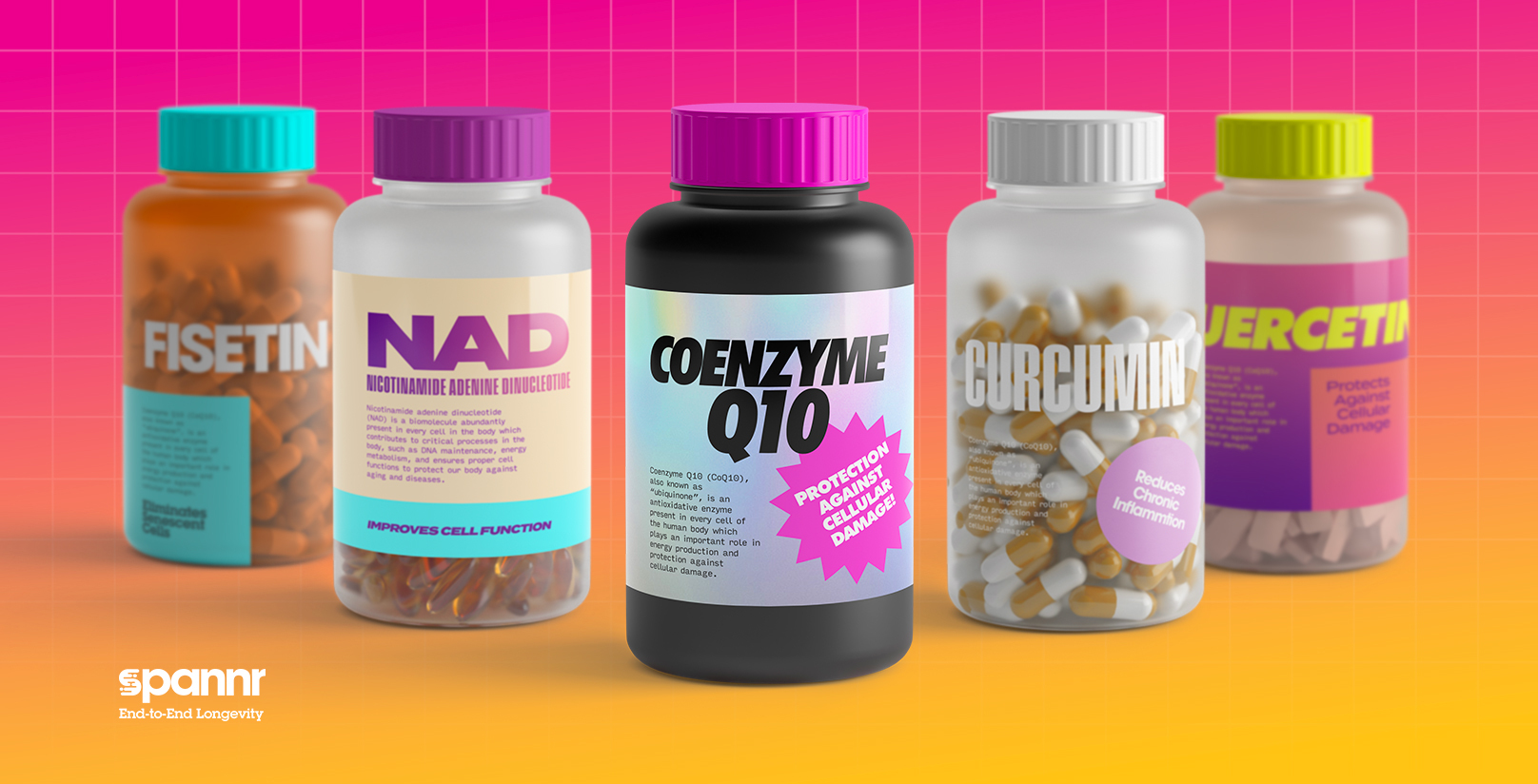
We all want to live a long and healthy life, but as we age, various forms of biological damage result in increased susceptibility for disease. As a result, longevity supplements are becoming increasingly popular as people look for ways to improve their health and extend their life. This article examines the science underpinning 7 popular longevity supplements.
What are longevity supplements?
Longevity supplements are supplements that slow the aging process and extend a person’s healthy lifespan. These supplements generally target one or more of the nine ‘hallmarks’ of aging, such as shortening of telomeres, mitochondrial dysfunction, inflammation, or the accumulation of ‘zombie’ senescent cells.
Prescription medicines vs supplements
Supplements are not regulated by the US Food and Drug Administration (FDA), meaning they do not have to go through rigorous testing in mice and in human clinical trials before they can be sold. As a result, while some longevity supplements are marketed as ‘anti-aging,’ many differ in the strength of evidence supporting their efficacy.
Prescription medicines, on the other hand, require a high level of scientific evidence before they can be approved for sale. There are currently no prescription medicines approved by the FDA for aging, although preliminary studies suggest that metformin, a prescription drug for Type 2 diabetes, may promote longevity, and clinical trials are being planned to test its efficacy.
Why take longevity supplements?
Supplements may be one of several interventions that promote longevity and better mental and physical health in older age. Taking longevity supplements may be more cost-effective than treating a particular age-related disease down the line.
Longevity supplements represent one means of slowing the aging process, in addition to regular exercise, good sleep habits, a healthy diet, and others. Both younger and older adults may benefit from consuming longevity supplements, however, the efficacy of these supplements have not been validated in large-scale human trials.
Longevity supplements
Seven popular longevity supplements and the evidence supporting them are described below:
1. NAD+ boosting supplements
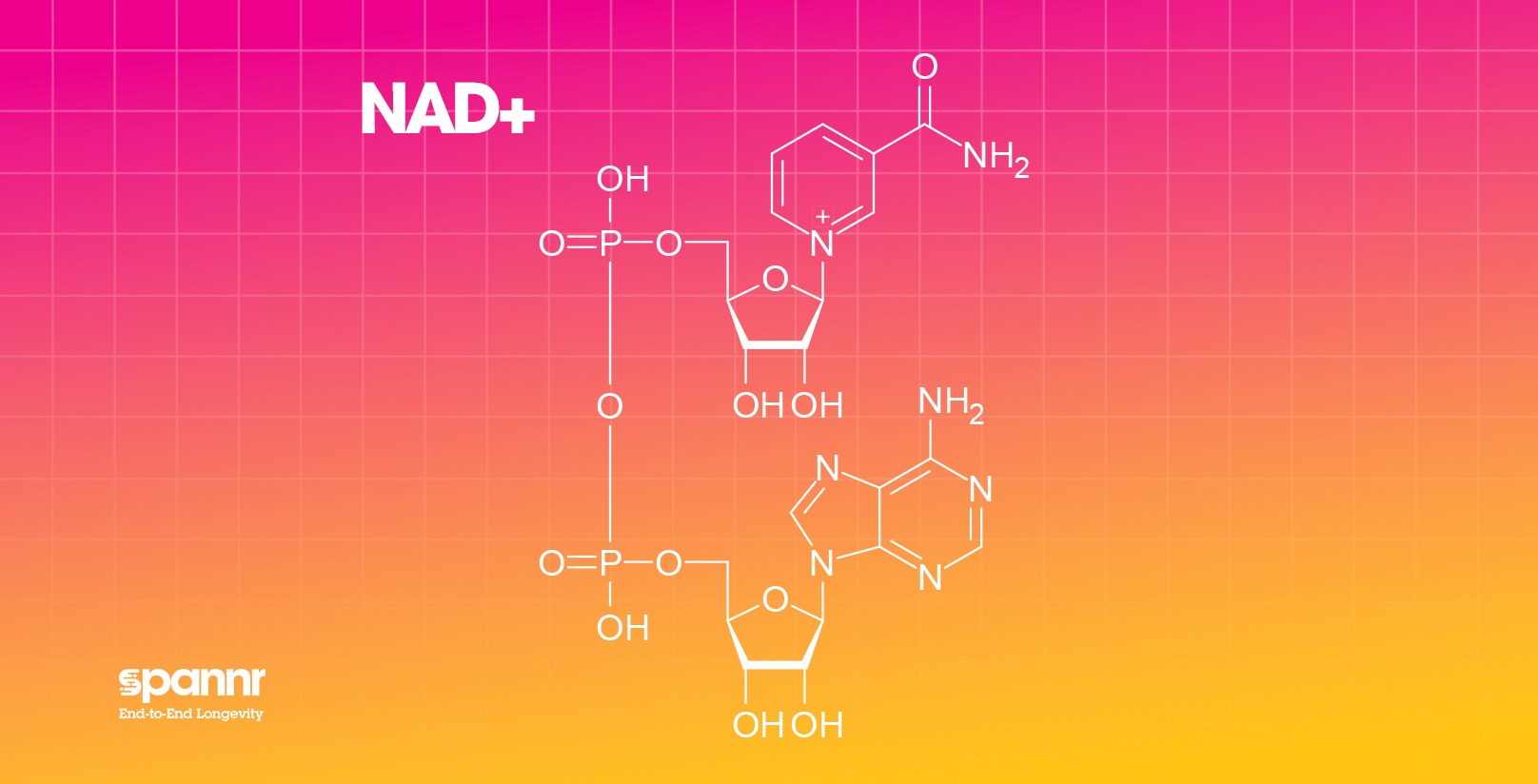
Nicotinamide adenine dinucleotide (NAD) is a biomolecule abundantly present in every cell in the body. NAD+ is the oxidized form of NAD which contributes to critical processes in the body, such as DNA maintenance, energy metabolism, and ensures proper cell functions to protect our body against aging and diseases.
By age 50, NAD+ levels are just half of our youthful levels, and by age 80, NAD+ levels may drop to just 1-10% of youthful levels. Deficiency of NAD+ is thought to be related to the development of many chronic diseases, as part of accelerating the aging process. Studies have suggested that a high level of NAD+ may promote longevity and healthy aging.
Nicotinamide mononucleotide (NMN) and other NAD+ boosting supplements have recently been popularized by Harvard professor David Sinclair as a longevity supplement. NMN is a form of vitamin B3 which is believed to raise the level of NAD+ in the body cells.
Several mechanisms have been proposed to explain the potential longevity benefits associated with supplements that boost levels of NAD+, including:
- Activating sirtuin enzymes: sirtuins are a family of proteins that play a fundamental role in metabolic regulation and inflammatory responses. Activation of sirtuins have been linked to improved cardiovascular health in mice and may promote longevity in humans.
- Promoting mitochondrial health: mitochondria are a component of the cell that greatly depends on NAD+ activity for energy production. Mitochondrial dysfunction is one of the hallmarks of aging and has been associated with development of several chronic diseases, such as cardiovascular diseases and cancer. Thus, a high level of NAD+ may be required for optimal mitochondrial function and longevity.
Recent NMN controversy
Recently, the Food and Drug Administration (FDA) banned NMN from being sold as supplements in the US. The FDA board has decided that NMN cannot be marketed as a longevity supplement and it is being investigated as a pharmaceutical drug in human clinical trials.
2. Curcumin
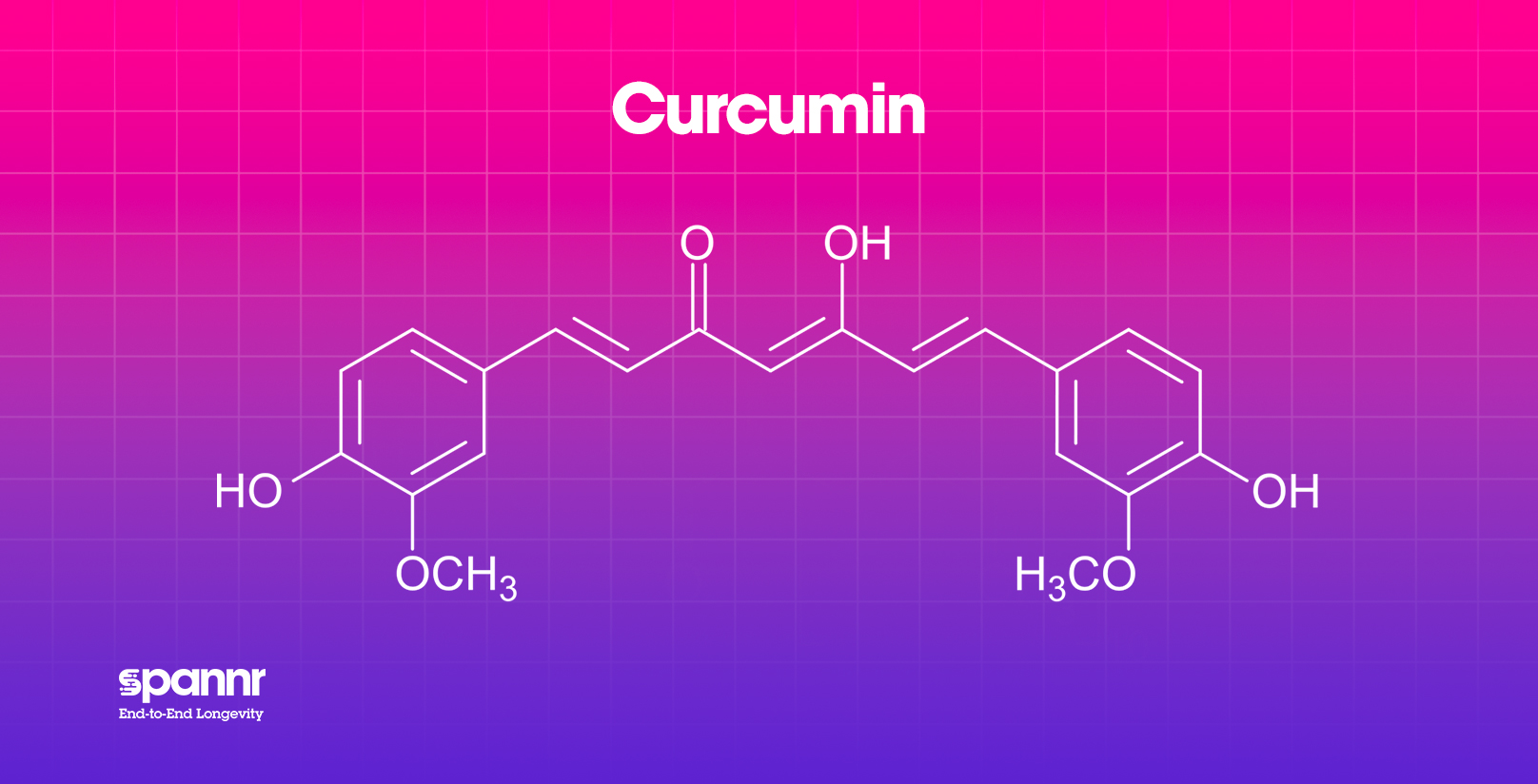
Curcumin is the active ingredient in turmeric, and is a polyphenol responsible for the yellow pigment in the root. In Ayurvedic medicine, turmeric has long been used as a home remedy against bruises, burns, poor digestion, and for menstruation regulation.
Recent studies have linked curcumin to healthy aging and offer a possible longevity benefit. Curcumin extends lifespan in fruit flies, and some of the proposed health benefits in humans include:
- Reduced inflammation: chronic inflammation is believed to be a key driver of aging, and scientists often use the term “inflammaging” to describe this phenomenon. Curcumin contains anti-inflammatory properties and can increase the level of antioxidants in the body. Curcumin has been shown to reduce biomarkers of inflammation such as interleukin 6 (L-6) and C-reactive protein (CRP), Curcumin has also been shown to regulate the expression of NF-kB protein complex associated with chronic inflammation.
- Reduced senescent cells: senescent cells are dysfunctional cells that have been damaged beyond repair and are sometimes referred to as “zombie cells” due to their harmful effect. The accumulation of senescent cells has been associated with the aging process and diseases such as Alzheimer’s. Curcumin has been shown to reduce senescent cells in studies of human cells, though more research is needed to confirm this effect.
- Regulation of metabolic pathways: curcumin has been reported to inhibit the mTOR signaling pathway, which is associated with a reduced risk of chronic diseases.
- Preventing glycation: glycation occurs when sugar molecules attach themselves to muscle and fat tissues, causing tissue damage, and is thought to contribute to aging. Preclinical studies and one human trial have suggested that curcumin may prevent and reduce the severity of glycation.
One limitation of curcumin is that it is poorly digested when taken orally, but various formulas have been generated to improve absorption.
3. Coenzyme Q10
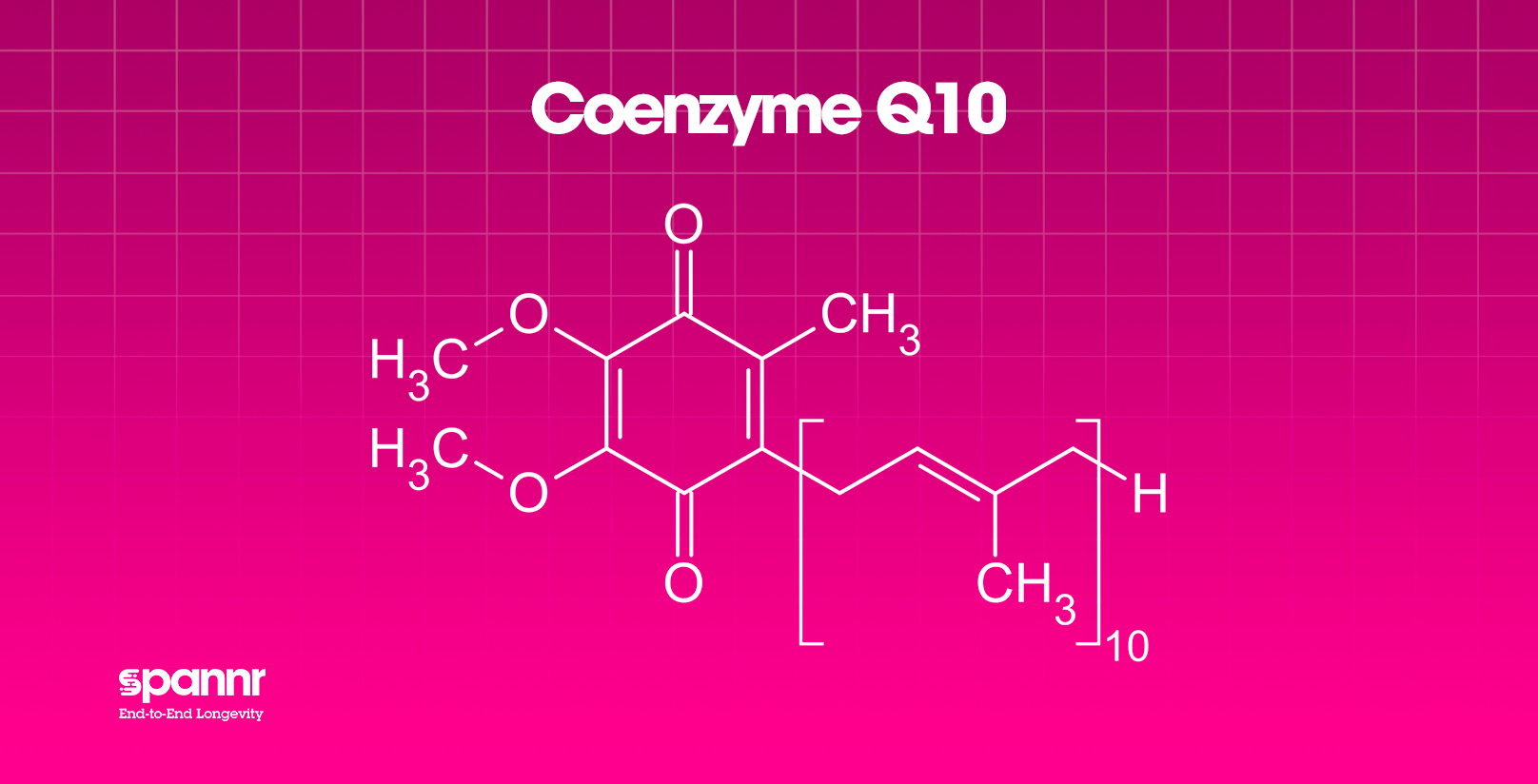
Coenzyme Q10 (CoQ10), also known as “ubiquinone”, is an antioxidative enzyme present in every cell of the human body which plays an important role in energy production and protection against cellular damage.
Sources of CoQ10 include organ meats, oily fish, eggs, and nuts, though the amount of CoQ10 found in these dietary sources are not enough to significantly increase the CoQ10 levels in your body.
The decline in CoQ10 level across age has been linked to age-related diseases such as cardiovascular diseases, chronic kidney diseases, and cancer. Researchers have suggested that older adults may benefit from CoQ10 supplements.
Some of the proposed longevity benefits of CoQ10 include:
- Reducing mitochondrial damage: One of the hallmarks of aging is mitochondrial dysfunction. The mitochondrial theory of aging states that the accumulation of stress and damage to the mitochondria is a driving factor for aging in humans. As an antioxidant, CoQ10 is believed to reduce oxidative stress and damage to the mitochondria by targeting free radicals, unstable atoms that can cause cell damage.
In this way, CoQ10 is thought to promote healthy aging. The clinical benefit of the supplement has been demonstrated in clinical studies:
- Slowing neurodegeneration: CoQ10 has been suggested to reduce the severity of neurodegenerative disorders in mice models of Alzheimer’s and Parkinson’s disease. A clinical trial demonstrated that CoQ10 supplements can reduce functional decline by 44% in patients with early form of Parkinsons’ disease.
- Protecting against cancers: clinical studies have pointed out that low levels of CoQ10 greatly increase risks of prostate and breast cancer, and CoQ10 supplementation has been proposed to reduce such risks.
4. Fisetin
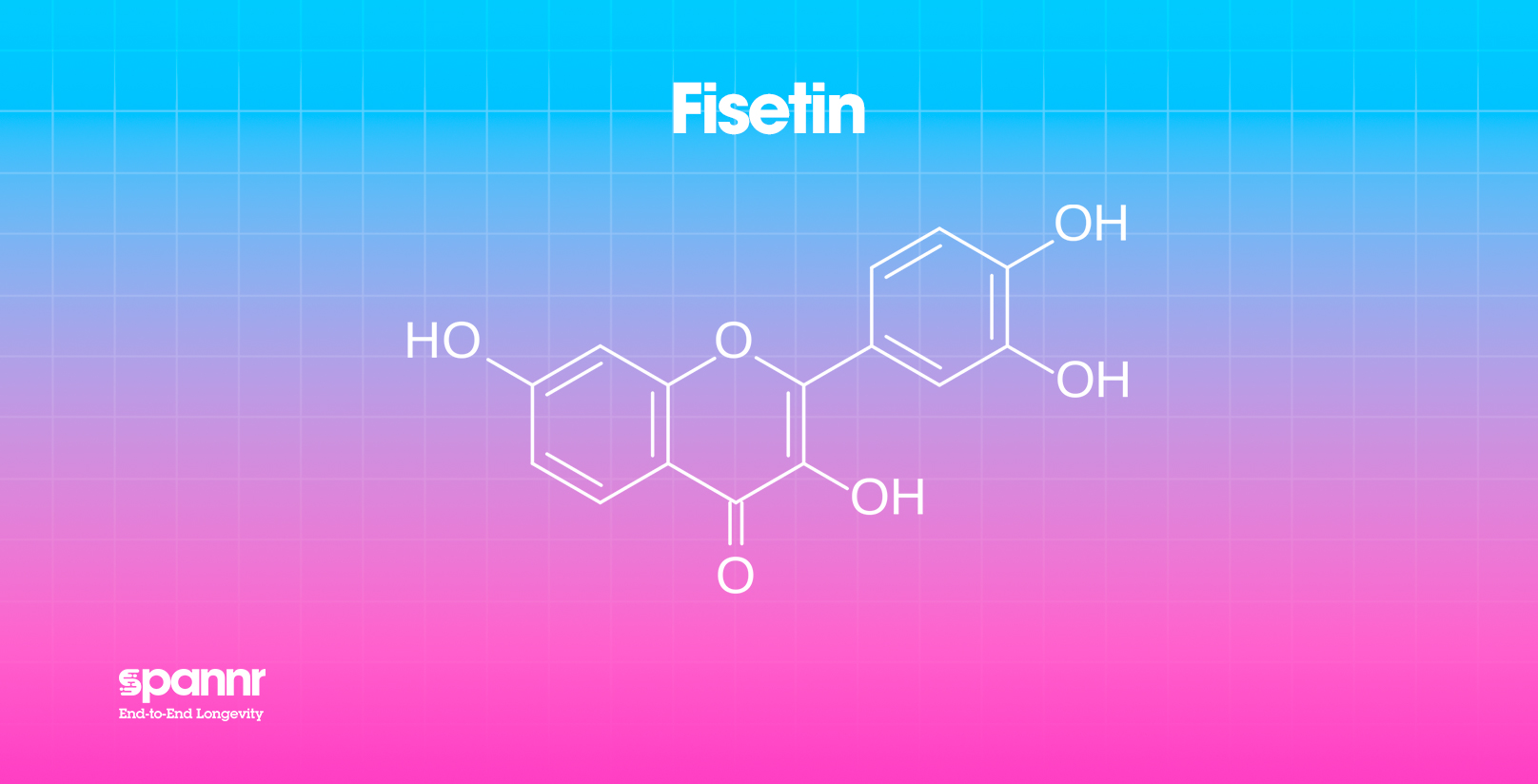
Fisetin is a naturally-occurring flavonoid found in various fruits and vegetables, such as strawberries, apples, onions and cucumbers. Recent research has suggested that fisetin may offer a possible longevity benefit in humans, through the following mechanisms:
- Eliminating senescent cells: Fisetin is thought to promote longevity in humans by removing senescent cells. By killing senescent cells, fisetin may act as a powerful senolytic to slow aging.
- Calorie restriction mimetic: Fisetin imitates some effects of a prolonged low-calorie diet which may promote longevity, such as increasing levels of antioxidants. Caloric restriction has been shown to extend lifespan in multiple organisms, such as mice and monkeys.
- Reducing inflammation: proposed that improved brain function effects are due to promoting the anti-inflammatory signaling pathways of fisetin.
Studies in mice and humans have identified several health benefits of fisetin, such as:
- Improved brain function: Fisetin has been shown to improve cognitive functions, memory formation, and provide protective effects against neurological diseases, such as Alzheimer’s disease, Parkinson’s disease, and ALS (amyotrophic lateral sclerosis) in mice models.
- Anti-cancer effects: Fisetin has been shown to prevent cancers and reduce the spread of existing tumors. One study in mice showed that fisetin inhibited the growth and migration of breast cancer cells. Various mechanisms have been proposed to explain this effect, such as an enhanced self-cleaning process known as autophagy, inhibition of cancer cell migration, and obstruction of tumor cells blood vessels formation.
- Improved skin appearance: Fisetin consumption has been associated with improved skin health and the reduction of wrinkles. One study showed that fisetin can promote a youthful complexion through the reduction of collagen degradation and the inflammatory response in one type of connective tissue cell in mice studies.
5. Spermidine
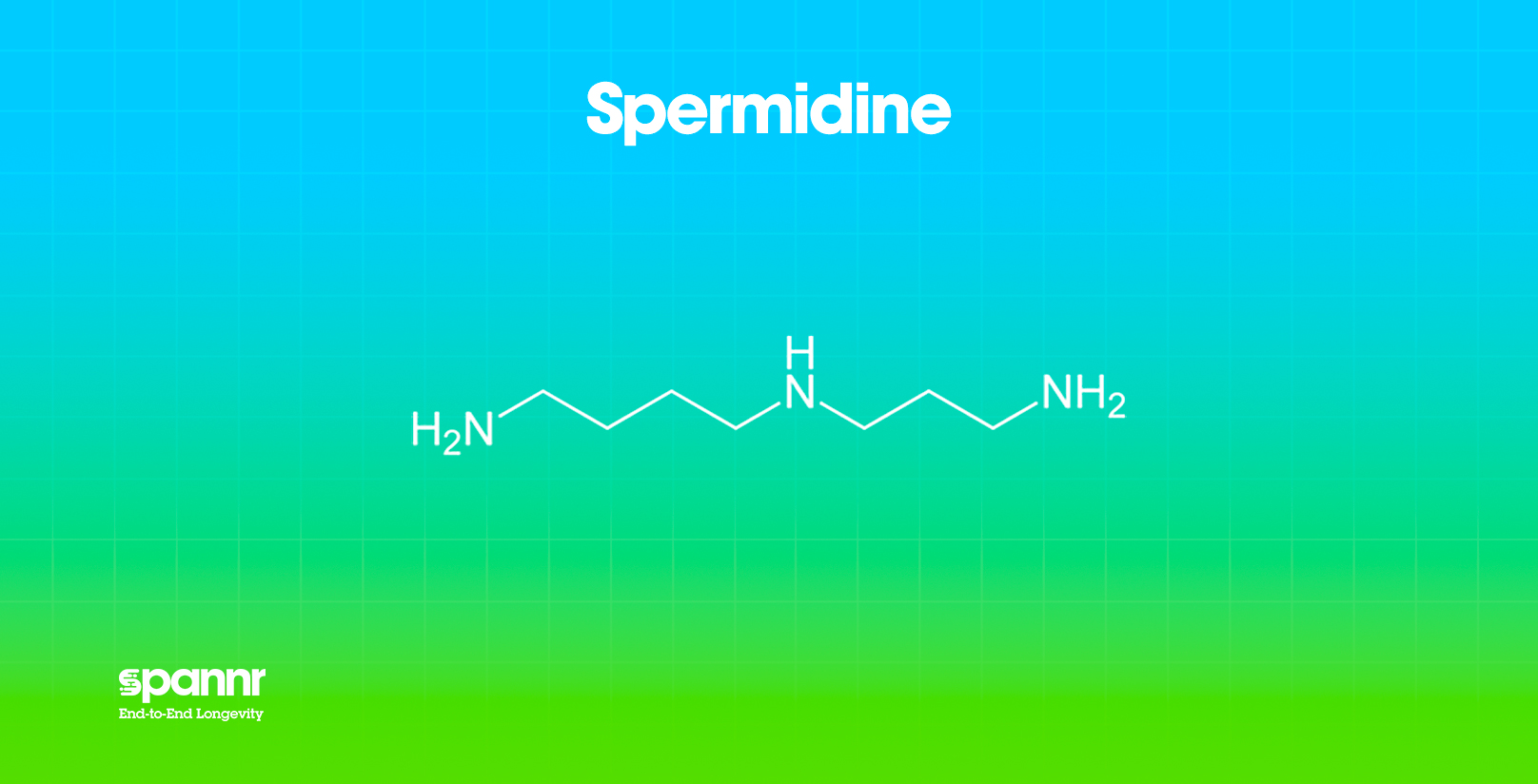
Spermidine is a polyamine found in all cells responsible for assisting in autophagy, which is a cellular housekeeping mechanism associated with longevity. Some dietary sources of spermidine include whole grains, mushrooms, aged cheeses, and soy products.
Consumption of spermidine has been associated with many health benefits, such as:
- Promoting autophagy: Spermidine is thought to promote a cellular clearing process called autophagy. Autophagy is a process of cellular rejuvenation which is thought to promote longevity through various housekeeping mechanisms that mimic fasting.
- Spermidine is thought to act as a calorie restriction mimetic, which means that it simulates the effects of fasting on the body.
- Protects against telomere attrition: one of the nine hallmarks of aging is telomere attrition, the breakdown of the DNA protective caps at the end of our chromosome. Studies in mice samples have linked increased spermidine intake to a reduction in telomere attrition.
Studies in mice and humans have identified several health benefits of spermidine, such as:
- Slowing cognitive decline and improving memory: preclinical studies have linked spermidine to improved cognitive functions. A study in mice models of Alzheimer’s disease demonstrates that spermidine reduced neuroinflammation and promoted brain health. Another mice study demonstrated that supplementation with spermidine reduced cognitive impairments.
- Protecting against certain types of cancer: a study conducted in HeLa cells suggests that spermidine may be effective in preventing cervical cancer through activating autophagy, a cellular housekeeping mechanism. Spermidine has been suggested to be protective against other types of cancer, such as lung cancer, colorectal cancer, and breast cancer.
6. Quercetin
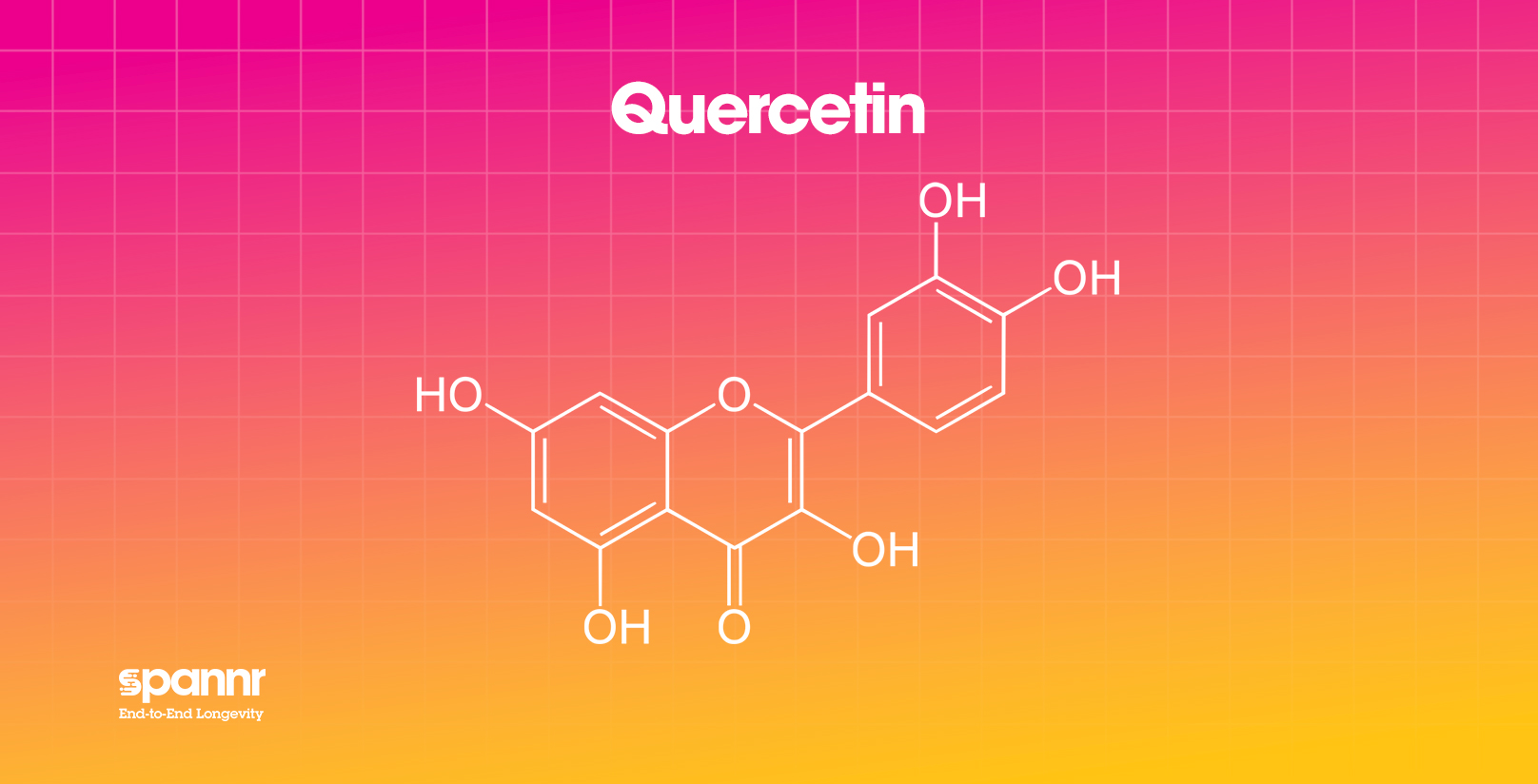
Quercetin is a flavonoid responsible for yellow pigments commonly found in onions, olive oil, capers, and legumes. Quercetin is an active ingredient in several home remedies in Asian countries, with quercetin to treat various disorders such as alcohol cravings and lung cancer.
Some of the potential longevity mechanisms of quercetin include:
- Anti-inflammatory properties: Like many flavonoids, quercetin is an antioxidant and contains anti-inflammatory properties which are believed to aid longevity.
- Promotes efficient protein production: maintenance of protein health in the body is very important. Misfolded proteins and lack of protein regulation are the reasons we age. Studies have tied quercetin to improved protein production and regulation.
- Improving NAD+ levels: numerous studies suggest that quercetin increases NAD+ levels in the blood. NAD+ is a biomolecule abundantly present in all body cells which contributes to vital mechanisms, such as the maintenance of sleep cycle, DNA reparation, and protecting cells from stress.
- Quercetin as a senolytic compound: quercetin was popularized as a longevity supplement based on proposed strong senolytic activity, but additional research in human epithelial senescent cells showed that quercetin may not be an effective senolytic.
Some studies have linked quercetin to longevity health benefits, such as:
- Supports brain and the immune system: a study in aging mice demonstrated that supplementation with quercetin can improve function outcomes for cognitive disorders.
7. Resveratrol
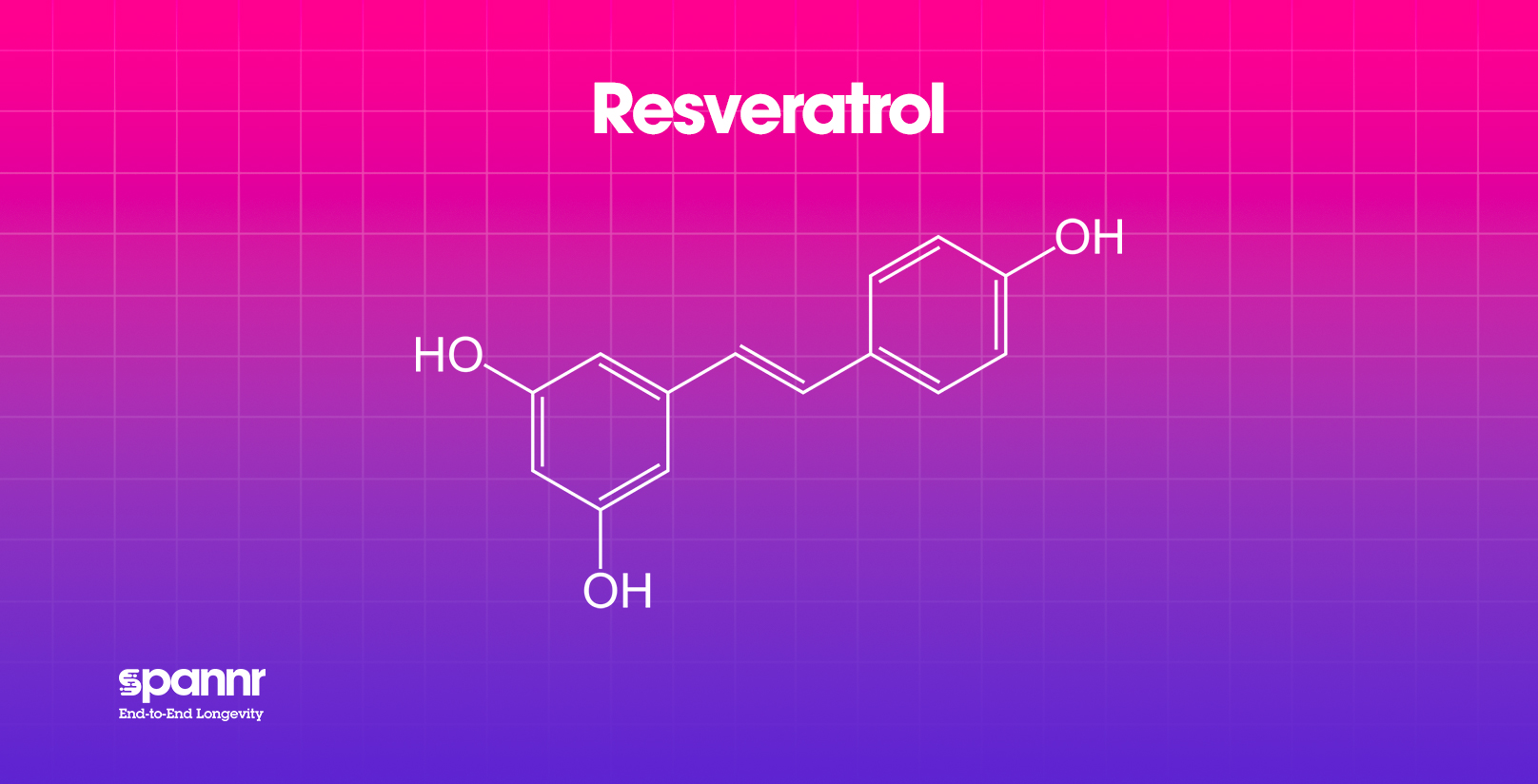
Popularized by David Sinclair in his book Lifespan, resveratrol has been proposed to contain many longevity health benefits. Resveratrol is a natural polyphenol produced by plants in response to injury or pathogenic infections and is found in red wine and grapes. However, the amount of resveratrol found in these dietary sources is insufficient to noticeably raise blood levels of resveratrol, for example, only 500 mg of resveratrol is found in 40 liters of wine.
Studies have proposed that resveratrol promotes longevity by various mechanisms, such as:
- Improved body functions: a pre-clinical study suggests that resveratrol may benefit mitochondrial health, which in turn enhances cardiovascular, muscular, and nervous systems in mice samples. Though, the study finds no correlation of resveratrol to improved longevity.
- Reduction of oxidative stress: oxidative stress is a phenomenon caused by accumulations and imbalances of reactive oxygen derivatives, which contribute to aging through various cellular malfunctions.
- Elevation of inflammatory responses: chronic inflammation has been linked to aging, which scientists often describe as “inflammaging.” Some of the ways resveratrol reduce aging is through suppression of pro-inflammatory genes and the inhibition of enzymes that contribute to inflammation.
- Regulation of cell death: dysregulation of cell death can contribute to diseases, such as cancer, autoimmune diseases, and neurodegenerative diseases. Resveratrol has been suggested to modulate autophagy and downregulation of genes that oppose cell death.
Some health benefits associated with resveratrol consumption include:
- Reduced risks of heart diseases: one study suggested that resveratrol upregulates an enzyme responsible for the production of nitric oxide, a gaseous compound vital for blood pressure regulation and inhibition of platelet aggregation.
- Anti-cancer effects: a preclinical study conducted in rat samples suggests that resveratrol can inhibit the growth and proliferation of several types of cancer cells, including colon, breast, liver, pancreatic, white blood cells, and lungs. One way in which resveratrol achieves this is through inhibition of carcinogenesis, a multi-step process required to initiate cancer formation.
- Reduced obesity and diabetes risks: resveratrol has been proposed to confer anti-obesity and anti-diabetic effects. One of the proposed mechanisms is the promotion of lipolysis, the breakdown of fat cells.
A critical review of longevity supplements
The Interventions Testing Program (ITP) is a multi-institutional program designed to assess the validity of longevity agents in mice samples. Some supplements have been assessed in the ITP and shown to possess no longevity benefit, such as resveratrol and curcumin. Therefore, more human clinical studies are required to validate the benefit of longevity supplements in humans.
Summary
With people living longer lives, the market for longevity supplements is growing. These supplements are taken to promote healthy aging and increase one’s healthy lifespan.
Several supplements such as curcumin, coenzyme Q10, NAD+ boosters, fisetin, spermidine, quercetin show promise, but ongoing research is still needed in the field to clarify the role of these supplements in extending healthy lifespan.
Longevity supplements are not a magic bullet, and it is still important to consider other lifestyle factors, such as a healthy diet and a regular exercise regimen, to sustain a long and healthy life.
- López-Otín, C., Blasco, M.A., Partridge, L., Serrano, M. and Kroemer, G. (2013). The Hallmarks of Aging. Cell, 153(6), pp.1194–1217. doi:10.1016/j.cell.2013.05.039. https://www.ncbi.nlm.nih.gov/pmc/articles/PMC3836174/
- Yeager-S, P. (2022). Regulations.gov. [online] www.regulations.gov. https://www.regulations.gov/document/FDA-2022-S-0023-0051
- Novelle, M.G., Ali, A., Diéguez, C., Bernier, M. and de Cabo, R. (2016). Metformin: A Hopeful Promise in Aging Research. Cold Spring Harbor Perspectives in Medicine, [online] 6(3), p.a025932. doi:10.1101/cshperspect.a025932. https://pubmed.ncbi.nlm.nih.gov/26931809/
- Ames, B.N. (2018). Prolonging healthy aging: Longevity vitamins and proteins. Proceedings of the National Academy of Sciences, 115(43), pp.10836–10844. doi:10.1073/pnas.1809045115. https://www.ncbi.nlm.nih.gov/pmc/articles/PMC6205492/
- Gremeaux, V., Gayda, M., Lepers, R., Sosner, P., Juneau, M. and Nigam, A. (2012). Exercise and longevity. Maturitas, [online] 73(4), pp.312–317. doi:10.1016/j.maturitas.2012.09.012. https://www.sciencedirect.com/science/article/abs/pii/S0378512212003015
- Mazzotti, D.R., Guindalini, C., Moraes, W.A. dos S., Andersen, M.L., Cendoroglo, M.S., Ramos, L.R. and Tufik, S. (2014). Human longevity is associated with regular sleep patterns, maintenance of slow wave sleep, and favorable lipid profile. Frontiers in Aging Neuroscience, [online] 6. doi:10.3389/fnagi.2014.00134. https://www.ncbi.nlm.nih.gov/pmc/articles/PMC4067693/
- Fontana, L. and Partridge, L. (2015). Promoting Health and Longevity through Diet: From Model Organisms to Humans. Cell, [online] 161(1), pp.106–118. doi:10.1016/j.cell.2015.02.020. https://www.ncbi.nlm.nih.gov/pmc/articles/PMC4547605/
- Covarrubias, A.J., Perrone, R., Grozio, A. and Verdin, E. (2020). NAD+ metabolism and its roles in cellular processes during ageing. Nature Reviews Molecular Cell Biology, 22(2), pp.119–141. doi:10.1038/s41580-020-00313-x. https://pubmed.ncbi.nlm.nih.gov/33353981/
- Schultz, M.B. and Sinclair, D.A. (2016). Why NAD + Declines during Aging: It’s Destroyed. Cell Metabolism, 23(6), pp.965–966. doi:10.1016/j.cmet.2016.05.022. https://pubmed.ncbi.nlm.nih.gov/27304496/
- Aman, Y., Qiu, Y., Tao, J. and Fang, E.F. (2018). Therapeutic potential of boosting NAD+ in aging and age-related diseases. Translational Medicine of Aging, [online] 2, pp.30–37. doi:10.1016/j.tma.2018.08.003. https://www.sciencedirect.com/science/article/pii/S2468501118300063
- Sinclair, D., Laplante, M.D. and Delphia, C. (2019). Lifespan : why we age–and why we don’t have to. New York: Atria Books. https://www.amazon.com.au/Lifespan-Revolutionary-Science-Dont-Have/dp/1501191977
- Shade C. (2020). The Science Behind NMN-A Stable, Reliable NAD+Activator and Anti-Aging Molecule. Integrative medicine (Encinitas, Calif.), 19(1), 12–14. https://www.ncbi.nlm.nih.gov/pmc/articles/PMC7238909/
- Kane, A.E. and Sinclair, D.A. (2018). Sirtuins and NAD+in the Development and Treatment of Metabolic and Cardiovascular Diseases. Circulation Research, 123(7), pp.868–885. doi:10.1161/circresaha.118.312498. https://pubmed.ncbi.nlm.nih.gov/30355082/
- Srivastava, S. (2017). The Mitochondrial Basis of Aging and Age-Related Disorders. Genes, 8(12), p.398. doi:10.3390/genes8120398. https://pubmed.ncbi.nlm.nih.gov/29257072/
- Hatcher, H., Planalp, R., Cho, J., Torti, F.M. and Torti, S.V. (2008). Curcumin: From ancient medicine to current clinical trials. Cellular and molecular life sciences : CMLS, [online] 65(11), pp.1631–1652. doi:10.1007/s00018-008-7452-4. https://pubmed.ncbi.nlm.nih.gov/18324353/
- Suckow, B.K. and Suckow, M.A. (2006). Lifespan Extension by the Antioxidant Curcumin in Drosophila Melanogaster. International Journal of Biomedical Science : IJBS, [online] 2(4), pp.402–405. https://www.ncbi.nlm.nih.gov/pmc/articles/PMC3614642/
- Abdolahi, M., Sarraf, P., Javanbakht, M.H., Honarvar, N.M., Hatami, M., Soveyd, N., Tafakhori, A., Sedighiyan, M., Djalali, M., Jafarieh, A., Masoudian, Y. and Djalali, M. (2018). A Novel Combination of ω-3 Fatty Acids and Nano-Curcumin Modulates Interleukin-6 Gene Expression and High Sensitivity C-reactive Protein Serum Levels in Patients with Migraine: A Randomized Clinical Trial Study. CNS & Neurological Disorders – Drug Targets, 17(6), pp.430–438. doi:10.2174/1871527317666180625101643. https://pubmed.ncbi.nlm.nih.gov/29938621/
- Grabowska, W., Kucharewicz, K., Wnuk, M., Lewinska, A., Suszek, M., Przybylska, D., Mosieniak, G., Sikora, E. and Bielak-Zmijewska, A. (2015). Curcumin induces senescence of primary human cells building the vasculature in a DNA damage and ATM-independent manner. AGE, 37(1). doi:10.1007/s11357-014-9744-y. https://www.ncbi.nlm.nih.gov/pmc/articles/PMC4315775/
- van Deursen, J.M. (2014). The role of senescent cells in ageing. Nature, 509(7501), pp.439–446. doi:10.1038/nature13193. https://www.ncbi.nlm.nih.gov/pmc/articles/PMC4214092/
- Beevers, C., Zhou, H. and Huang, S. (2013). Hitting the Golden TORget: Curcumin’s Effects on mTOR Signaling. Anti-Cancer Agents in Medicinal Chemistry, 13(7), pp.988–994. doi:10.2174/1871520611313070004. https://www.ncbi.nlm.nih.gov/pmc/articles/PMC3638063/
- Alizadeh, M. and Kheirouri, S. (2017). Curcumin against advanced glycation end products (AGEs) and AGEs-induced detrimental agents. Critical Reviews in Food Science and Nutrition, 59(7), pp.1169–1177. doi:10.1080/10408398.2017.1396200. https://pubmed.ncbi.nlm.nih.gov/29185795/
- Prasad, S., Tyagi, A.K. and Aggarwal, B.B. (2014). Recent Developments in Delivery, Bioavailability, Absorption and Metabolism of Curcumin: the Golden Pigment from Golden Spice. Cancer Research and Treatment, [online] 46(1), pp.2–18. doi:10.4143/crt.2014.46.1.2. https://www.ncbi.nlm.nih.gov/pmc/articles/PMC3918523/
- Saini, R. (2011). Coenzyme Q10: The essential nutrient. Journal of Pharmacy and Bioallied Sciences, 3(3), p.466. doi:10.4103/0975-7406.84471. https://www.ncbi.nlm.nih.gov/pmc/articles/PMC3178961/
- Bank, G., Kagan, D. and Madhavi, D. (2011). Coenzyme Q10: Clinical Update and Bioavailability. Journal of Evidence-Based Complementary & Alternative Medicine, 16(2), pp.129–137. doi:10.1177/2156587211399438. https://journals.sagepub.com/doi/pdf/10.1177/2156587211399438
- Hernández-Camacho, J.D., Bernier, M., López-Lluch, G. and Navas, P. (2018). Coenzyme Q10 Supplementation in Aging and Disease. Frontiers in Physiology, [online] 9. doi:10.3389/fphys.2018.00044. https://www.ncbi.nlm.nih.gov/pmc/articles/PMC5807419/
- Barcelos, I.P. de and Haas, R.H. (2019). CoQ10 and Aging. Biology, [online] 8(2), p.28. doi:10.3390/biology8020028. https://www.ncbi.nlm.nih.gov/pmc/articles/PMC6627360/
- Wei, Y.H., Ma, Y.S., Lee, H.C., Lee, C.F. and Lu, C.Y. (2001). Mitochondrial theory of aging matures–roles of mtDNA mutation and oxidative stress in human aging. Zhonghua Yi Xue Za Zhi = Chinese Medical Journal; Free China Ed, [online] 64(5), pp.259–270. https://pubmed.ncbi.nlm.nih.gov/11499335/.
- Dumont, M., Kipiani, K., Yu, F., Wille, E., Katz, M., Calingasan, N.Y., Gouras, G.K., Lin, M.T. and Beal, M.F. (2011). Coenzyme Q10 Decreases Amyloid Pathology and Improves Behavior in a Transgenic Mouse Model of Alzheimer’s Disease. Journal of Alzheimer’s Disease, [online] 27(1), pp.211–223. doi:10.3233/jad-2011-110209. https://pubmed.ncbi.nlm.nih.gov/21799249/
- Shults, C.W. (2002). Effects of Coenzyme Q10 in Early Parkinson Disease. Archives of Neurology, 59(10), p.1541. doi:10.1001/archneur.59.10.1541. https://pubmed.ncbi.nlm.nih.gov/12374491/
- Chai, W., Cooney, R.V., Franke, A.A., Caberto, C.P., Wilkens, L.R., Le Marchand, L., Goodman, M.T., Henderson, B.E. and Kolonel, L.N. (2011). Plasma Coenzyme Q10 Levels and Prostate Cancer Risk: The Multiethnic Cohort Study. Cancer Epidemiology Biomarkers & Prevention, 20(4), pp.708–710. doi:10.1158/1055-9965.epi-10-1309. https://pubmed.ncbi.nlm.nih.gov/21297042/
- Cooney, R.V., Dai, Q., Gao, Y.-T., Chow, W.-H., Franke, A.A., Shu, X.-O., Li, H., Ji, B., Cai, Q., Chai, W. and Zheng, W. (2011). Low Plasma Coenzyme Q10 Levels and Breast Cancer Risk in Chinese Women. Cancer Epidemiology Biomarkers & Prevention, 20(6), pp.1124–1130. doi:10.1158/1055-9965.epi-10-1261. https://www.ncbi.nlm.nih.gov/pmc/articles/PMC3545677/
- Khan, N., Syed, D.N., Ahmad, N. and Mukhtar, H. (2013). Fisetin: A Dietary Antioxidant for Health Promotion. Antioxidants & Redox Signaling, 19(2), pp.151–162. doi:10.1089/ars.2012.4901. https://www.ncbi.nlm.nih.gov/pmc/articles/PMC3689181/
- Yousefzadeh, M.J., Zhu, Y., McGowan, S.J., Angelini, L., Fuhrmann-Stroissnigg, H., Xu, M., Ling, Y.Y., Melos, K.I., Pirtskhalava, T., Inman, C.L., McGuckian, C., Wade, E.A., Kato, J.I., Grassi, D., Wentworth, M., Burd, C.E., Arriaga, E.A., Ladiges, W.L., Tchkonia, T. and Kirkland, J.L. (2018). Fisetin is a senotherapeutic that extends health and lifespan. EBioMedicine, 36, pp.18–28. doi:10.1016/j.ebiom.2018.09.015. https://pubmed.ncbi.nlm.nih.gov/30279143/
- Singh, S., Garg, G., Singh, A.K., Bissoyi, A. and Rizvi, S.I. (2019). Fisetin, a potential caloric restriction mimetic, attenuates senescence biomarkers in rat erythrocytes. Biochemistry and Cell Biology, 97(4), pp.480–487. doi:10.1139/bcb-2018-0159. https://pubmed.ncbi.nlm.nih.gov/30624963/
- Hofer, S.J., Davinelli, S., Bergmann, M., Scapagnini, G. and Madeo, F. (2021). Caloric Restriction Mimetics in Nutrition and Clinical Trials. Frontiers in Nutrition, 8. doi:10.3389/fnut.2021.717343. https://www.frontiersin.org/articles/10.3389/fnut.2021.717343/full
- Maher, P. (2015). How fisetin reduces the impact of age and disease on CNS function. Frontiers in Bioscience, 7(1), pp.58–82. doi:10.2741/s425. https://pubmed.ncbi.nlm.nih.gov/25961687/
- Li, J., Gong, X., Jiang, R., Lin, D., Zhou, T., Zhang, A., Li, H., Zhang, X., Wan, J., Kuang, G. and Li, H. (2018). Fisetin Inhibited Growth and Metastasis of Triple-Negative Breast Cancer by Reversing Epithelial-to-Mesenchymal Transition via PTEN/Akt/GSK3β Signal Pathway. Frontiers in Pharmacology, 9. doi:10.3389/fphar.2018.00772. https://www.frontiersin.org/articles/10.3389/fphar.2018.00772/full
- Jia, S., Xu, X., Zhou, S., Chen, Y., Ding, G. and Cao, L. (2019). Fisetin induces autophagy in pancreatic cancer cells via endoplasmic reticulum stress- and mitochondrial stress-dependent pathways. Cell Death & Disease, [online] 10(2), p.142. doi:10.1038/s41419-019-1366-y. https://www.nature.com/articles/s41419-019-1366-y
- Bhat, T.A., Nambiar, D., Pal, A., Agarwal, R. and Singh, R.P. (2011). Fisetin inhibits various attributes of angiogenesis in vitro and in vivo–implications for angioprevention. Carcinogenesis, 33(2), pp.385–393. doi:10.1093/carcin/bgr282. https://academic.oup.com/carcin/article/33/2/385/2463884
- Wu, P.-Y., Lyu, J.-L., Liu, Y.-J., Chien, T.-Y., Hsu, H.-C., Wen, K.-C. and Chiang, H.-M. (2017). Fisetin Regulates Nrf2 Expression and the Inflammation-Related Signaling Pathway to Prevent UVB-Induced Skin Damage in Hairless Mice. International Journal of Molecular Sciences, 18(10), p.2118. doi:10.3390/ijms18102118. https://www.ncbi.nlm.nih.gov/pmc/articles/PMC5666800/
- Madeo, F., Bauer, M.A., Carmona-Gutierrez, D. and Kroemer, G. (2018). Spermidine: a physiological autophagy inducer acting as an anti-aging vitamin in humans? Autophagy, [online] 15(1), pp.165–168. doi:10.1080/15548627.2018.1530929. https://www.ncbi.nlm.nih.gov/pmc/articles/PMC6287690/
- Wirth, A., Wolf, B., Huang, C.-K., Glage, S., Hofer, S.J., Bankstahl, M., Bär, C., Thum, T., Kahl, K.G., Sigrist, S.J., Madeo, F., Bankstahl, J.P. and Ponimaskin, E. (2021). Novel aspects of age-protection by spermidine supplementation are associated with preserved telomere length. GeroScience. doi:10.1007/s11357-020-00310-0. https://europepmc.org/article/pmc/8110654
- Wang, I-Fang., Tsai, K.-J. and Shen, C.-K.J. (2015). Spermidine on neurodegenerative diseases. Cell Cycle, 14(5), pp.697–698. doi:10.1080/15384101.2015.1006551. https://www.ncbi.nlm.nih.gov/pmc/articles/PMC4614629/
- Freitag, K., Sterczyk, N., Wendlinger, S., Obermayer, B., Schulz, J., Farztdinov, V., Mülleder, M., Ralser, M., Houtman, J., Fleck, L., Braeuning, C., Sansevrino, R., Hoffmann, C., Milovanovic, D., Sigrist, S.J., Conrad, T., Beule, D., Heppner, F.L. and Jendrach, M. (2022). Spermidine reduces neuroinflammation and soluble amyloid beta in an Alzheimer’s disease mouse model. Journal of Neuroinflammation, 19(1). doi:10.1186/s12974-022-02534-7. https://www.ncbi.nlm.nih.gov/pmc/articles/PMC9250727/
- Schroeder, S., Hofer, S.J., Zimmermann, A., Pechlaner, R., Dammbrueck, C., Pendl, T., Marcello, G.M., Pogatschnigg, V., Bergmann, M., Müller, M., Gschiel, V., Ristic, S., Tadic, J., Iwata, K., Richter, G., Farzi, A., Üçal, M., Schäfer, U., Poglitsch, M. and Royer, P. (2021). Dietary spermidine improves cognitive function. Cell Reports, [online] 35(2), p.108985. doi:10.1016/j.celrep.2021.108985. https://europepmc.org/article/med/33852843
- Chen, Y., Zhuang, H., Chen, X., Shi, Z. and Wang, X. (2018). Spermidine‑induced growth inhibition and apoptosis via autophagic activation in cervical cancer. Oncology Reports. doi:10.3892/or.2018.6377. https://www.spandidos-publications.com/10.3892/or.2018.6377
- Tse, R.T.-H., Wong, C.Y.-P., Chiu, P.K.-F. and Ng, C.-F. (2022). The Potential Role of Spermine and Its Acetylated Derivative in Human Malignancies. International Journal of Molecular Sciences, 23(3), p.1258. doi:10.3390/ijms23031258. https://www.mdpi.com/1422-0067/23/3/1258/htm
- Li, Y., Yao, J., Han, C., Yang, J., Chaudhry, M., Wang, S., Liu, H. and Yin, Y. (2016). Quercetin, Inflammation and Immunity. Nutrients, [online] 8(3), p.167. doi:10.3390/nu8030167. https://www.ncbi.nlm.nih.gov/pmc/articles/PMC4808895/
- Liang, X., Hu, X., Zhang, X. and Fu, H. (2020). ASF (a Compound of Traditional Chinese Medicine) in the treatment of patients with alcohol dependence. Medicine, 99(52), p.e23899. doi:10.1097/md.0000000000023899. https://www.ncbi.nlm.nih.gov/pmc/articles/PMC7769360/
- Li, Y., Yao, J., Han, C., Yang, J., Chaudhry, M., Wang, S., Liu, H. and Yin, Y. (2016). Quercetin, Inflammation and Immunity. Nutrients, [online] 8(3), p.167. doi:10.3390/nu8030167. https://www.ncbi.nlm.nih.gov/pmc/articles/PMC4808895/
- Chondrogianni, N., Kapeta, S., Chinou, I., Vassilatou, K., Papassideri, I. and Gonos, E.S. (2010). Anti-ageing and rejuvenating effects of quercetin. Experimental Gerontology, 45(10), pp.763–771. doi:10.1016/j.exger.2010.07.001. https://hal.archives-ouvertes.fr/hal-00625941/document
- Escande, C., Nin, V., Price, N.L., Capellini, V., Gomes, A.P., Barbosa, M.T., O’Neil, L., White, T.A., Sinclair, D.A. and Chini, E.N. (2012). Flavonoid Apigenin Is an Inhibitor of the NAD+ase CD38: Implications for Cellular NAD+ Metabolism, Protein Acetylation, and Treatment of Metabolic Syndrome. Diabetes, 62(4), pp.1084–1093. doi:10.2337/db12-1139. https://www.ncbi.nlm.nih.gov/pmc/articles/PMC3609577/
- Levine, D.C., Hong, H., Weidemann, B.J., Ramsey, K.M., Affinati, A.H., Schmidt, M.S., Cedernaes, J., Omura, C., Braun, R., Lee, C., Brenner, C., Peek, C.B. and Bass, J. (2020). NAD+ Controls Circadian Reprogramming through PER2 Nuclear Translocation to Counter Aging. Molecular Cell, 78(5), pp.835-849.e7. doi:10.1016/j.molcel.2020.04.010. https://pubmed.ncbi.nlm.nih.gov/32369735/
- Wilk, A., Hayat, F., Cunningham, R., Li, J., Garavaglia, S., Zamani, L., Ferraris, D.M., Sykora, P., Andrews, J., Clark, J., Davis, A., Chaloin, L., Rizzi, M., Migaud, M. and Sobol, R.W. (2020). Extracellular NAD+ enhances PARP-dependent DNA repair capacity independently of CD73 activity. Scientific Reports, 10(1). doi:10.1038/s41598-020-57506-9. https://www.nature.com/articles/s41598-020-57506-9#citeas
- Zhu, Y., Zhao, K., Tong, Y., Zhou, Y., Wang, Y., Zhao, P. and Wang, Z. (2016). Exogenous NAD+ decreases oxidative stress and protects H2O2-treated RPE cells against necrotic death through the up-regulation of autophagy. Scientific Reports, 6(1). doi:10.1038/srep26322. https://www.nature.com/articles/srep26322#citeas
- Hwang, H.V., Tran, D.T., Rebuffatti, M.N., Li, C.-S. and Knowlton, A.A. (2018). Investigation of quercetin and hyperoside as senolytics in adult human endothelial cells. PLOS ONE, 13(1), p.e0190374. doi:10.1371/journal.pone.0190374. https://journals.plos.org/plosone/article?id=10.1371/journal.pone.0190374
- Li, H., Chen, F.-J., Yang, W.-L., Qiao, H.-Z. and Zhang, S.-J. (2021). Quercetin improves cognitive disorder in aging mice by inhibiting NLRP3 inflammasome activation. Food & Function, 12(2), pp.717–725. doi:10.1039/d0fo01900c. https://pubmed.ncbi.nlm.nih.gov/33338087/
- Weiskirchen, S. and Weiskirchen, R. (2016). Resveratrol: How Much Wine Do You Have to Drink to Stay Healthy? Advances in Nutrition: An International Review Journal, 7(4), pp.706–718. doi:10.3945/an.115.011627. https://academic.oup.com/advances/article/7/4/706/4568690
- Ungvari, Z., Sonntag, W.E., de Cabo, R., Baur, J.A. and Csiszar, A. (2011). Mitochondrial Protection by Resveratrol. Exercise and sport sciences reviews, [online] 39(3), pp.128–132. doi:10.1097/JES.0b013e3182141f80. https://www.ncbi.nlm.nih.gov/pmc/articles/PMC3123408/
- Pizzino, G., Irrera, N., Cucinotta, M., Pallio, G., Mannino, F., Arcoraci, V., Squadrito, F., Altavilla, D. and Bitto, A. (2017). Oxidative Stress: Harms and Benefits for Human Health. Oxidative Medicine and Cellular Longevity, [online] 2017(8416763), pp.1–13. doi:10.1155/2017/8416763. https://www.ncbi.nlm.nih.gov/pmc/articles/PMC5551541/
- Malaguarnera (2019). Influence of Resveratrol on the Immune Response. Nutrients, 11(5), p.946. doi:10.3390/nu11050946. https://www.ncbi.nlm.nih.gov/pmc/articles/PMC6566902/#:~:text=Resveratrol%20can%20suppress%20the%20toll,to%20its%20anti%2Dinflammation%20properties.
- Pfeffer, C.M. and Singh, A.T.K. (2018). Apoptosis: A Target for Anticancer Therapy. International Journal of Molecular Sciences, 19(2), p.448. doi:10.3390/ijms19020448. https://www.ncbi.nlm.nih.gov/pmc/articles/PMC5855670/#:~:text=Apoptosis%20in%20Cancer&text=The%20loss%20of%20apoptotic%20control,interfere%20with%20differentiation%20%5B2%5D.
- Kobayashi, S.D. (2005). Spontaneous neutrophil apoptosis and regulation of cell survival by granulocyte macrophage-colony stimulating factor. Journal of Leukocyte Biology, 78(6), pp.1408–1418. doi:10.1189/jlb.0605289. https://jlb.onlinelibrary.wiley.com/doi/full/10.1189/jlb.0605289
- Tatton, W.G. and Olanow, C.W. (1999). Apoptosis in neurodegenerative diseases: the role of mitochondria. Biochimica et Biophysica Acta (BBA) – Bioenergetics, 1410(2), pp.195–213. doi:10.1016/s0005-2728(98)00167-4. https://www.sciencedirect.com/science/article/pii/S0005272898001674#:~:text=We%20believe%20that%20apoptosis%20is,and%20release%20of%20mitochondrial%20AIFs.
- Fu, X., Li, M., Tang, C., Huang, Z. and Najafi, M. (2021). Targeting of cancer cell death mechanisms by resveratrol: a review. Apoptosis, 26(11-12), pp.561–573. doi:10.1007/s10495-021-01689-7. https://pubmed.ncbi.nlm.nih.gov/34561763/
- Li, H., Xia, N., Hasselwander, S. and Daiber, A. (2019). Resveratrol and Vascular Function. International Journal of Molecular Sciences, [online] 20(9). doi:10.3390/ijms20092155. https://www.ncbi.nlm.nih.gov/pmc/articles/PMC6539341/
- Ko, J.-H., Sethi, G., Um, J.-Y., Shanmugam, M.K., Arfuso, F., Kumar, A.P., Bishayee, A. and Ahn, K.S. (2017). The Role of Resveratrol in Cancer Therapy. International Journal of Molecular Sciences, [online] 18(12). doi:10.3390/ijms18122589. https://www.ncbi.nlm.nih.gov/pmc/articles/PMC5751192/
- Aguirre, L., Fernández-Quintela, A., Arias, N. and Portillo, M. (2014). Resveratrol: Anti-Obesity Mechanisms of Action. Molecules, 19(11), pp.18632–18655. doi:10.3390/molecules191118632. https://www.ncbi.nlm.nih.gov/pmc/articles/PMC6271102/
- National Institute on Aging. (n.d.). Interventions Testing Program (ITP). [online] Available at: https://www.nia.nih.gov/research/resource/interventions-testing-program-itp
- Strong, R., Miller, R.A., Astle, C.M., Baur, J.A., de Cabo, R., Fernandez, E., Guo, W., Javors, M., Kirkland, J.L., Nelson, J.F., Sinclair, D.A., Teter, B., Williams, D., Zaveri, N., Nadon, N.L. and Harrison, D.E. (2012). Evaluation of Resveratrol, Green Tea Extract, Curcumin, Oxaloacetic Acid, and Medium-Chain Triglyceride Oil on Life Span of Genetically Heterogeneous Mice. The Journals of Gerontology Series A: Biological Sciences and Medical Sciences, 68(1), pp.6–16. doi:10.1093/gerona/gls070. https://www.ncbi.nlm.nih.gov/pmc/articles/PMC4032600/
About the Author
Sign Up For Our Newsletter
Weekly insights into the future of longevity
